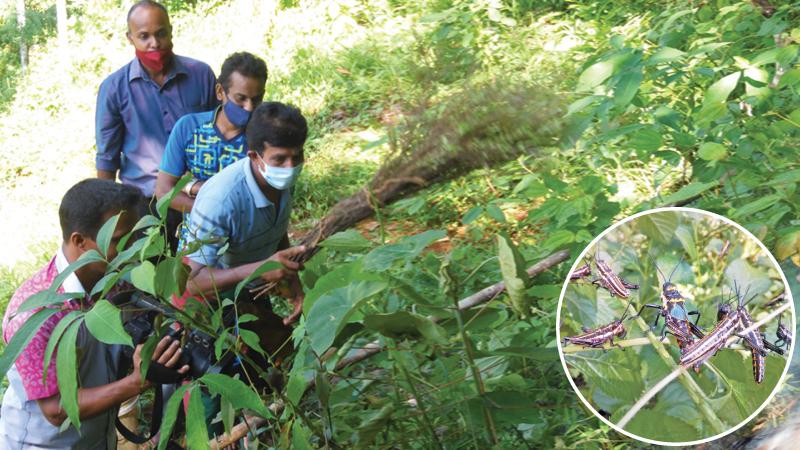
Famers are advised to send an SMS to 1920 or 071 201 1920 including the name of their area and information of crops that are damaged, as swarms of yellow spotted locusts spread to several areas since its initial invasion on June 1.
The insect, which grows into the size of a pen cap, was first reported from Kurunegala and by Thursday (4) has spread to over 20 divisions in the district. Now the swarms have reached farmlands including those in Kegalle, Matara and Hambantota.
“I haven’t seen anything like this before. When the swarms settle on a tree only the twigs remain when they leave. They eat all the leaves within a day or two,” said A. D. P. Ratnasiri, a farmer from Katupitiya in Kurunegala said.
 Namal Karunarathna |
Ratnasiri grows coconut, teak and bananas. All these crops are key targets of the yellow spotted locusts which devour their leaves, leaving devastation behind.
When contacted, the Katupitiya farmer was advised by the officers of the local Agriculture Department office in Kurunegala to smoke, set fire or use chemicals to kill the army of locusts. However, his efforts were not fruitful.
He fears that his plantation will be destroyed by the locusts. If their plantations are destroyed it will be a second blow to the farmers who were already affected by the ongoing pandemic.
W. A. Abeywickrama, a farmer from Delgamuwa in Kegalle, was more successful in tackling the spread of yellow spotted locusts on his farmland.
“Officers from the Agriculture office came after I gave them a call. I called them after seeing about 100 of these insects on the rubber plantation. When the officers came, they found thousands of them in another place. They gave me thel (chemicals) to kill these insects,” Abeywickrama said. He said he hasn’t seen the insect on his farm before.
However, the yellow spotted locust is not entirely an alien to Sri Lanka. Endemic to the country it was spotted in Kurunegala and the surrounding areas from time to time. Experts believe that the imbalance in climatic conditions is causing the aggravation of its number.
“This locust was seen in the country before. I think this outbreak is a result of the changes in the natural balance of environmental conditions. Extreme weather patterns could be helping these insects to proliferate,” Kegalle’s Deputy Provincial Director of the Department of Agriculture Nilma Rajapaksha said.
She also said that the locust has spread to most parts of Kegalle. “We have to be very careful when killing these insects . We can’t disturb the balance by using excess pesticides,” she added.
She said that the best way to destroy the swarm is by using ‘mechanical ways’ such as burning.
The desert locusts in India (not those seen in Sri Lanka, according to the Department of Agriculture) are seen in swarms of millions and could stretch to four miles in proportion. The insects spread to Rajasthan in India from Pakistan in early May and have since reached Gujarat, Madhya Pradesh, Uttar Pradesh and Maharashtra.
According to the Food and Agriculture Organization, as reported by Indian media, the’ locust crisis’ aggravation can be traced to Cyclone Amphan that wreaked havoc in India on May 20. It is believed that heavy winds caused the widespread of the locust.
Additional Director at the Department of Agriculture, Anura Wijetunga, told the Sunday Observer that there is a possibility for the desert locust to also reach Sri Lanka as a result of the wind patterns these days. He said winds blowing through the South West corner into Sri Lanka cover parts of India.
The yellow spotted locust in Sri Lanka is now in its instar stage. This means that it is still in the stage where it hops and would later develop wings and this calls for the immediate intervention of all parties concerned to destroy the raging swarms before they reproduce.
“These insects usually come out in February and March and by September and October they develop wings.
One locust can lay up to 80 eggs,” said Assistant Director of Agriculture of the Kurunegala Segment H. L. M. Jinadari Lanka.
She added that the locust laid eggs on the ground. “Therefore, what we have to do is find these spots and destroy the eggs,” she said.
In a bid to stop the insects from spreading further, the Government has called the military to be on standby in case its assistance is needed. Currently, the Disaster Management Center is using chemicals to kill the locusts, while officers of the Department of Agriculture are informing farmers and home growers to burn them.
Last year, the Sena caterpillar destroyed over half of the corn cultivation. First discovered in a farmland in Ampara it gradually spread to other districts including Kurunegala, Matara and Monaragala.
“The Sena attacked only 100 plant species, but this locust can eat 200 plant species,” the National Organiser of the All Ceylon Peasants Federation, Namal Karunaratne said indicating that the country is fighting a bigger pest.He said that his organisation has received information that the yellow spotted locust has now spread to Hambantota and Matara.
“The coconut leaf, which we also use to thatch roofs, is eaten by this locust very easily. This means that it can eat anything,” Karunaratne said adding “It is destroying the lifeline of trees. We have to stop it before it is too late.”
